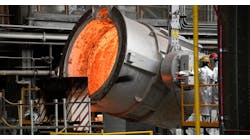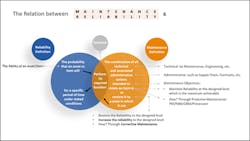Maintenance is fundamentally about sound asset management, and should be regarded as a category of asset management. An important feature of any asset is its ability to perform as specified, and at all times in a consistent, repeatable manner,… in other words “reliably.” Asset reliability can be ascertained through reliability assessments, which often are overlooked as a type of maintenance.
Reliability assessments – the focus of this report – are a vital link between the maintenance function and the management of assets throughout an organization.
What are reliability assessments?
An online search for the term ‘reliability assessments definition’ provides surprisingly very few viable hits. Even so, a definition of ‘reliability assessment’ should focus on the word ‘reliability.’ In the context of maintenance, reliability is the ability of an asset to perform its required function effectively for a specified period under specific conditions.
A reliability assessment is primarily predicated on the breakdown analysis. A systematic study of each failure is needed, including:
1. Why the failure occurred;
2. To what extent it compromised an asset’s functionality; and
3. The consequences of any failure.
The assessments aim to prevent asset breakdowns in the future, as well as predict them, where possible.
However, breakdowns are not the only form of asset failure. An asset working subpar should be considered unreliable. A case in point is an inconsistent bottle-filling machine in a brewery, which may have dire consequences in terms of both production output and quality control.
Therefore, a reliability assessment focuses principally on the actual reliability of a given asset, such as the accuracy of a drilling machine in a metalworking shop. Equally, this assessment can be used to ascertain the reliability of a specific component within a machine, such as an electromechanical limit switch used by a CNC machine in the engineering department of a car manufacturer.
The presumption is that repeated use of a given asset should render the same reliable result for the entirety of the asset’s prescribed lifetime. Anything less should be considered a non-conformance and de facto evidence of unreliability.
The relationship between maintenance and reliability
Although assessing reliability should be central to maintenance management, there are instances in which reliability and maintenance may differ from each other. If we look at limitations, maintenance can, at best, ensure only that an asset is optimized but cannot make it more reliable than intended.
Reliability-focused engineering, however, can ensure that an asset is modified to make it even more reliable than originally designed.
However, the interdependence of reliability and maintenance is far greater than any differences that may exist. That is because maintenance and reliability have one overriding end goal: to ensure that assets are optimized and downtime minimized as much as possible. This is achieved by improving equipment reliability and performance. The correlation between maintenance and undertaking reliability assessments can be seen in this diagram:
Why conduct reliability assessments?
Improvement is critical to both maintenance and reliability, which is why these assessments could be conducted as part of a ‘maintenance effectiveness assessment and improvement strategy’ session.
There are numerous benefits to undertaking reliability assessments regularly. These include:
• Spearheading a reliability-focused regime within your maintenance department:
• Providing an objective ‘snapshot’ of how the maintenance function is performing including highlighting any technical or logistical deficiencies in said function
• Improved productivity
• Decreased asset-related downtime rates
• Overall departmental or organizational efficiency drive
• Homing in on needed improvements based on factors like the criticality and projected timelines thereof.
Reliability-centered maintenance vs risk-based maintenance
So, should one advocate for reliability-centered maintenance, as opposed to a risk-based approach? That depends on a variety of key factors, among them the key differences between the two forms of maintenance. A program based on reliability-centered maintenance, or RCM, is the one based on problem identification. Not only should there be greater asset reliability and increased productivity, but also less maintenance and fewer breakdowns and repairs.
Risk-based maintenance, or RbM, prioritizes assets according to their risk rating. A risk assessment is the basis of this maintenance, in which the risk profile of assets is calculated based on probability of failure and the consequences thereof, i.e. likelihood and severity, respectively. An RbM program flows directly from these risk assessments.
Therefore, RCM prioritizes functionality while RbM focuses on risk. These are very different priorities — just because jet fuel pumps at an airport are engineered to be more reliable regarding fuel flow rates doesn’t mean that said jet fuel is any less hazardous.
Another key difference between the two types of maintenance is that reliability maintenance tends to focus only on the most critical assets. Risk-based maintenance, on the other hand, should assess all assets to assign meaningful levels of risk, such as ‘high,’ ‘medium,’ and ‘low’ risk.
Nevertheless, the two maintenance approaches are different sides of the same coin in that they seek to achieve the same in terms of optimized maintenance. There still must be a risk-based focus on maintenance, particularly in the context of a risk management system. An example of this is criticality analysis (CA), a risk-based process that helps to predict possible asset failure so as not to resort to reactive maintenance.
Unreliability is an existential threat to any asset. That is because reliability is necessarily essential to asset functionality and, in turn, its ROI and very viability. In any organization the function that is most apt for addressing the issue of asset reliability is maintenance. It is the best maintenance function for assessing the reliability of assets within the context of a sound maintenance regime.
Ultimately, the relationship between reliability and maintenance should be a symbiotic one. Done correctly, reliability assessments should enhance the maintenance function of a facility, not to mention its bottom line.
Bryan Christiansen is the founder and CEO of Limble CMMS, a mobile CMMS software that helps plant managers organize, automate, and streamline maintenance operations.










